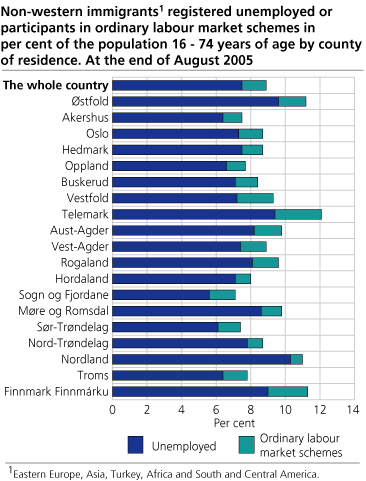Content
Published:
This is an archived release.
Unemployment strongly down among immigrants from new EU countries
The registered unemployment rate among immigrants decreased by 0.9 percentage points from 10.8 per cent to 9.9 per cent from August 2004 to August 2005. Immigrants from the new EU countries in Eastern Europe had the strongest decline in unemployment with 2.4 percentage points. In the population as a whole, unemployment fell from 4.1 to 3.7 per cent.
In these statistics, immigrants are defined as first-generation immigrants, i.e. people born abroad by foreign-born parents. They must also be registered as settled in Norway for at least six months. The figures are based on the Directorate of Labour's register of job seekers and are calculated as a fraction of the labour force.
New EU countries
The unemployment rate among immigrants from the new EU countries in Eastern Europe was 5.1 per cent at the end of August. This is a rate lower than the one we find among the western group from North America and Oceania, which was 5.6 per cent in the third quarter. In comparison, the unemployment rate among immigrants from other eastern European countries was 12.1 per cent.
19 per cent unemployment among Africans
Immigrants from Africa still had the highest unemployment rate in August, at 19.3 per cent compared with 13.1 per cent for immigrants from Asia. The rate among immigrants from South and Central America was 10.6 per cent, whereas unemployment among immigrants from Eastern Europe as a whole was 10.1 per cent. As in previous statistics, immigrants from the Nordic countries had the lowest rate at 4.0 per cent, closely followed by other western European immigrants at 4.1 per cent.
The high unemployment rate among African immigrants must be seen in connection with the relative high proportion of newly arrived immigrants in this group, especially refugees from Somalia.
Equalization between men and women
Male immigrants experienced the strongest fall in unemployment in the period, at 1.3 percentage points, while among immigrant women the fall was 0.5 percentage points. This development has caused equalization among immigrant men and women as unemployment is concerned. In the third quarter the rates were 9.9 and 9.8 per cent respectively. Traditionally we find a much higher registered unemployment rate among immigrant men than among women. In the population as a whole, women now have a higher rate than men, 3.8 versus 3.6 per cent.
Highest unemployment for immigrants with four to seven years of residence
The highest unemployment rate was recorded among immigrants with four to seven years of residence. In this group, the unemployment rate was 3.4 percentage points higher than among immigrants with a shorter period of residence - 9.5 per cent and 6.4 per cent and measured as a percentage of the population aged 16-74 years. This disparity is most likely due to the fact that newly arrived non-western immigrants -mostly refugees- go through language and job training before they enter the labour force as registered job seekers. For immigrants with seven years of residence or more, the unemployment rate fell to 5.6 per cent.
Labour market schemes
In August 2005 the number of immigrants participating on ordinary labour market schemes (job programmes) was 2 818 persons. They accounted for 34 per cent of all participants on such schemes in the third quarter and included mainly non-western immigrants. There has only been a marginal growth in the number of immigrant-participants compared to August 2004. In the population as a whole 8 181 participants were registered in August 2005, a number which was 1 800 participants fewer compared to August 2004.
As a percentage of the immigrant population, participation on labour market schemes was1.0 per cent in August 2005. In the population as a whole the participant rate was 0.2 per cent.
Immigrants from Africa had the highest participant rate in August 2005 at 1.9 per cent. Immigrants from Asia had a participation rate at 1.4 per cent, while the groups from Eastern Europe and South- and Central-America had a rate at 1.0 per cent each.
Tables:
- Table 1 Registered unemployed aged 16-74 years, by region of birth and sex. In absolute figures and per cent of the labour force. By the end of May 2004, August 2004, May 2005 and August 2005
- Table 2 Participants in ordinary labour market schemes (job programmes), by region of birth and sex. In absolute figures and per cent of persons aged 16-74 years. By the end of May 2004, August 2004, May 2005 and August 2005
- Table 3 Registered unemployed and participants in ordinary labour market schemes (job programmes), by region of birth and time of residence in Norway. In per cent of persons in total aged 16-74 years. By the end of August 2004 and 2005
- Table 4 Registered unemployed, by region of birth and county of residence. Absolute figures and in per cent of persons in total 16-74 years. By the end of August 2004
- Table 5 Registered unemployed, by region of birth and county of residence. Absolute figures and in per cent of persons in total 16-74 years. By the end of August 2005
- Table 6 Registered participants in ordinary labour market schemes, by region of birth and county of residence. Absolute figures and in per cent of persons in total 16-74 years. By the end of August 2005
- Table 7 Registered unemployed first generation immgrants from Eastern Europe, by EU status of the country of birth. Absolute figures and in per cent of the labour force. By the end of August 2004 and 2005
Additional information
The unemployment figures are based on the Norwegian Labour and Welfare Organisation’s register of jobseekers and are calculated as a share of the labour force, which is the sum of employed persons and registered unemployed persons, i.e. people offering their labour on the labour market.
Contact
-
Statistics Norway's Information Centre
E-mail: informasjon@ssb.no
tel.: (+47) 21 09 46 42

